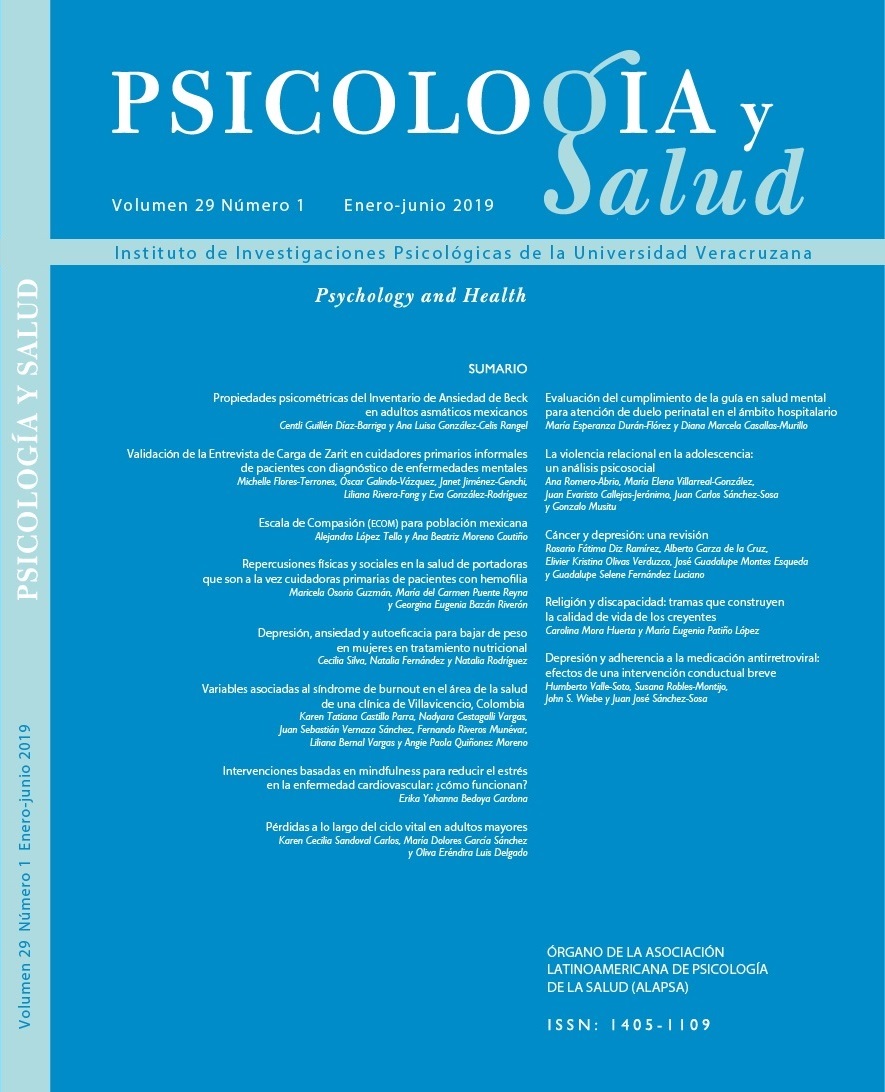Abstract
El constructo compasión utilizado en el presente estudio se definió como el profundo deseo de aliviar el sufrimiento propio y el de los demás. En esta investigación se describe el proceso de construcción y evaluación de las propiedades psicométricas de una escala de compasión para población mexicana. La muestra estuvo compuesta por 385 personas de al menos 16 años de edad de la población general. El análisis de consistencia interna de la escala mostró una alta confiabilidad, y el análisis factorial exploratorio una estructura de tres factores de primer orden y un factor general de segundo orden que explicaron 44.7% de la varianza. El análisis factorial confirmatorio comprobó esta estructura y arrojó buenos índices de ajuste relativo y general para la escala. En conclusión, el instrumento que aquí se presenta es confiable para evaluar la compasión en la población mexicana.References
Ashworth, F., Gracey, F. y Gilbert, P. (2011). Compassion focused therapy after traumatic brain injury: theoretical foundations and a case illustration. Brain Impairment. 12, 128-139. Recuperado de https://doi.org/10.1375/brim.12.2.128.
Bonermann, B. y Singer T. (2013). A cognitive neuroscience perspective. The resource model of compassion. En T. Singer y M. Bolz (Eds.): Compassion. Bridging practice and science (pp. 179-191). Munich: Max Planck Society.
Braehler, C., Gumley , A., Harper, J., Wallace, S., Norrie, J. y Gilbert, P. (2013). Exploring change processes in compassion focused therapy in psychosis: Results of a feasibility randomized controlled trial. British Journal of Clinical Psychology, 52, 199-214. Recuperado de http://onlinelibrary.wiley.com/doi/10.1111/bjc.12009/abstract.
Chang J., Fresco, J. y Green, B. (2014). The development and validation of the Compassion of Others’ Lives Scale (The COOL Scale). International Journal of Humanities and Social Science, 4(5), 33-42. Recuperado de http://www.ijhssnet.com/journals/Vol_4_No_5_March_2014/4.pdf.
Gale, C., Gilbert, P., Read, N. y Goss, K. (2014). An evaluation of the impact of introducing compassion focused therapy to a standard treatment programme for people with eating disorders. Clinical Psychology and Psychotherapy, 21, 1-12. Recuperado de https://www.ncbi.nlm.nih.gov/pubmed/22740105.
Germer, C. y Siegel, R. (2012). Wisdom and compassion: two wings of a bird. En R. Siegel y C. Germer (Eds.): Wisdom and compassion in psychotherapy: Deepening mindfulness in clinical practice (pp. 7-34). New York: The Guilford Press.
Gilbert, P. (2013). The flow of life. An evolutionary model of compassion. En T. Singer y M. Bolz (Eds.): Compassion. Bridging practice and science (pp.127-149). Munich: Max Planck Society.
Gilbert, P. y Choden (2013). Mindful compassion. London, UK: Constable-Robinson.
Gilbert, P. e Irons, C. (2004). A pilot exploration of the use of compassionate images in a group of self-critical people. Memory, 12, 507-516. Recuperado de https://www.ncbi.nlm.nih.gov/pubmed/15487546.
Gilbert, P. y Procter, S. (2006). Compassionate mind training for people with high shame and self-criticism: Overview and pilot study of a group therapy approach. Clinical Psychology and Psychotherapy, 13, 353-379.
Goetz, J.L., Keltner, D. y Simon-Thomas, E. (2010). Compassion: An evolutionary analysis and empirical review. Psychological Bulletin, 136(3), 351-374. Recuperado de http://doi.org/10.1037/a0018807.
Gyatso, T. (2001). An open heart: Practising compassion in every day life. New York: Little, Brown and Company.
Judge, L., Cleghorn, A., McEwan, K. y Gilbert, P. (2012). An exploration of group-based compassion focused therapy for a heterogeneous range of clients presenting to a community mental health team. International Journal of Cognitive Therapy, 5, 420-429. Recuperado de https://www.ncbi.nlm.nih.gov/pubmed/24217864.
Kelly, A.C., Zuroff, D.C., Foa, C.L. y Gilbert, P. (2010). Who benefits from training in self-compassionate self-regulation? A study of smoking reduction. Journal of Social and Clinical Psychology, 29, 727-755. Recuperado de http://guilfordjournals.com/doi/abs/10.1521/jscp.2010.29.7.727.
Kelly, A.C., Zuroff, D.C. y Shapira, L.B. (2009). Soothing oneself and resisting self-attacks: the treatment of two intrapersonal deficits in depression vulnerability. Cognitive Therapy and Research, 33, 301-313. Recuperado de https://link.springer.com/article/10.1007/s10608-008-9202-1.
Laithwaite, H., O’Hanlon, M., Collins, P., Doyle, P., Abraham, L., Porter, S. y Gumley, A. (2009). Recovery after psychosis (RAP): A compassion focused programme for individuals residing in high security settings. Behavioural and Cognitive Psychotherapy, 37, 511-526. Recuperado de https://www.ncbi.nlm.nih.gov/pubmed/19765353.
Leaviss, J. y Uttley, L. (2015). Psychotherapeutic benefits of compassion-focused therapy: An early systematic review. Psychological Medicine, 45(5), 927-945. Recuperado de http://doi.org/10.1017/S0033291714002141.
Lucre, K. y Corten, N. (2013). An exploration of group compassion-focused therapy for personality disorder. Psychology and Psychotherapy, 86, 387-400. Recuperado de https://www.ncbi.nlm.nih.gov/pubmed/24217864.
Martins, D., Nicholas, N.A., Shaheen, M., Jones, L. y Norris, K. (2013). The development and evaluation of a compassion scale. Journal of Health Care for the Poor and Underserved, 24(3), 1235-1246. Recuperado de http://doi.org/10.1353/hpu.2013.0148.
Mayhew, S. y Gilbert, P. (2008). Compassionate mind training with people who hear malevolent voices: a case series report. Clinical Psychology and Psychotherapy, 15, 113-138. Recuperado de https://www.ncbi.nlm.nih.gov/pubmed/19115433.
Mercadillo, R. (2012). Retratos del cerebro compasivo: una reflexión en la neurociencia social, los policías y el género. México: Centro de Estudios Filosóficos, Políticos y Sociales Vicente Lombardo Toledano.
Neff, K.D. (2003). The development and validation of a scale to measure self-compassion. Self and Identity, 2(3), 223-250. Recuperado de http://psycnet.apa.org/record/2003-05728-004.
Ozawa S., B., Dodson L., B., Raison, C. y Negi, L. (2012). Compassion and ethics: Scientific and practical approaches to the cultivation of compassion as a foundation for ethical subjectivity and well-being. Journal of Healthcare, Science and the Humanities, 2(1), 145-161.
Phillips, A. y Taylor, B. (2009). On kindness. London: Hamish Hamilton.
Singer, T. y Kilmecki, O.M. (2014). Empathy and compassion. Current Biology, 24(18), 875-878. Recuperado de http://www.cell.com/current-biology /abstract/S0960-9822(14)00770-2.
Singer, T. y Steinbeis, N. (2009). Differential roles of fairness-and compassion-based motivations for cooperation, defection, and punishment. Annals of the New York Academy of Sciences, 1167, 41-50. Recuperado de http://doi:10.1111/j.1749-6632.2009.04733.x.
Sprecher, S. y Fehr, B. (2005). Compassionate love for close others and humanity. Journal of Social and Personal Relationships, 22, 629-651. Recuperado de http://journals.sagepub.com/doi/abs/10.1177/0265407505056439.

